Student’s thesis on “equitable” archive finds wider audience and shows strength of master’s program
October 25, 2022
Emma Rath is a Master of Architecture student whose thesis is inspired by the “breath-taking” images she encounters in her work as an archivist at the Canadian Coast Guard Photography Archive.
“My thesis attempts to create an equitable archive that will cultivate a generous and welcoming space for visitors and will use the Canadian Coast Guard Photography Archive as a case study,” she explains.
“At this early stage of my thesis project, I am considering an array of possibilities such as physical building, digital databases, and interiors down to the chairs, tables, etc. that would occupy this archival space.”
Rath, 24, presented the beginnings of her master’s thesis work earlier his month at the International Design Communication Association conference at Auburn University in Alabama. She also recently published an essay in NiCHE, an online scholarly site of the Network in Canadian History & Environment.
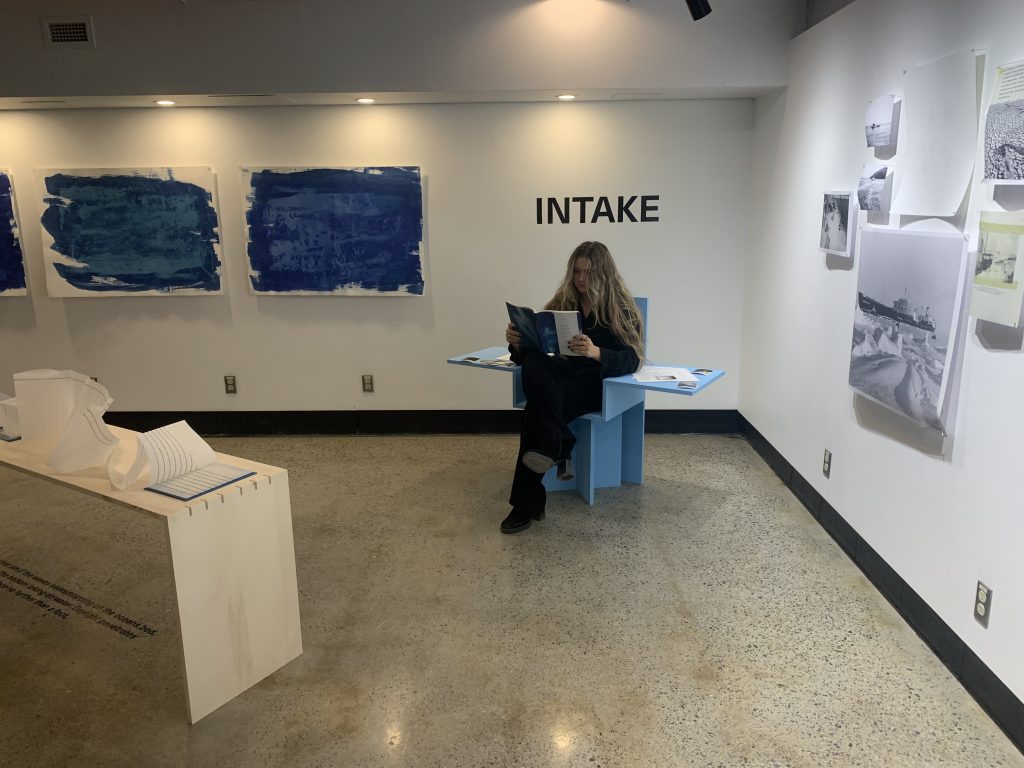
Emma Rath’s installation for the presentation of midterm thesis reviews.
Her research addresses the structure of water, inclusive archives, and searching for alternative taxonomies within archival spaces.
Rath had responded to the conference call for papers on the theme “Forgetting/Remembering: Design Communication for Experimental Traditions,” and her abstract was chosen from many submissions. The title of her paper is Data at Sea: Redesigning the Canadian Coast Guard Archive.
Associate Professor Catherine Bonier is Rath’s thesis supervisor. She says one of the strengths of the Azrieli School of Architecture & Urbanism at Carleton University lies in offering solid foundations for expansive research and design explorations.
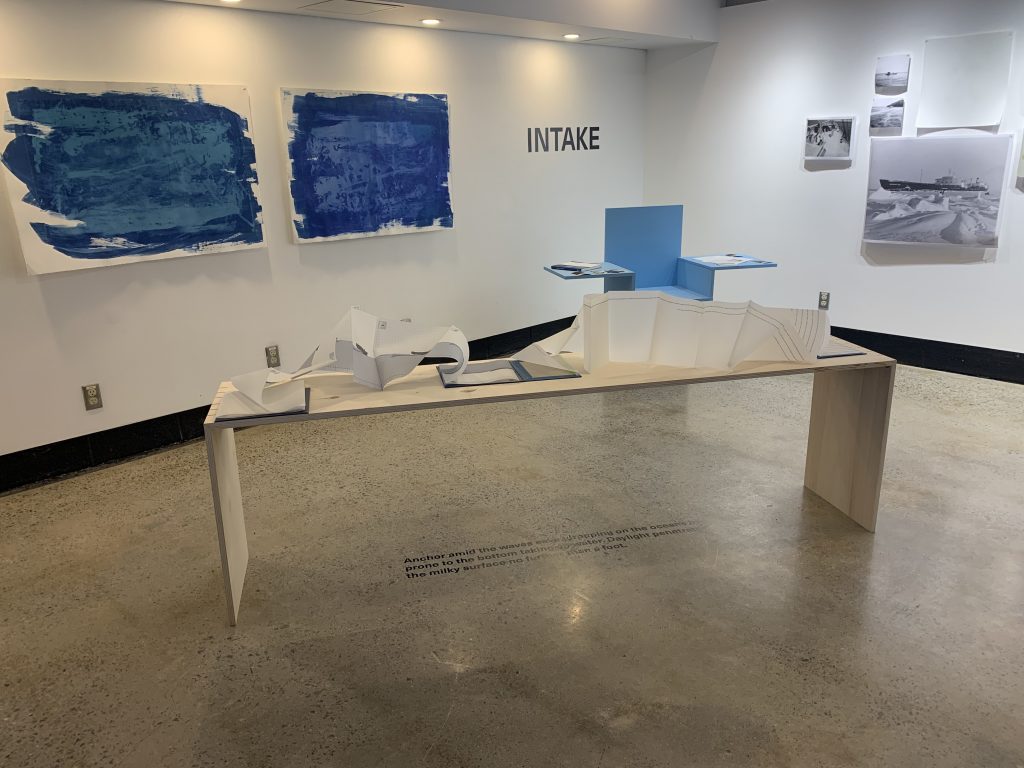
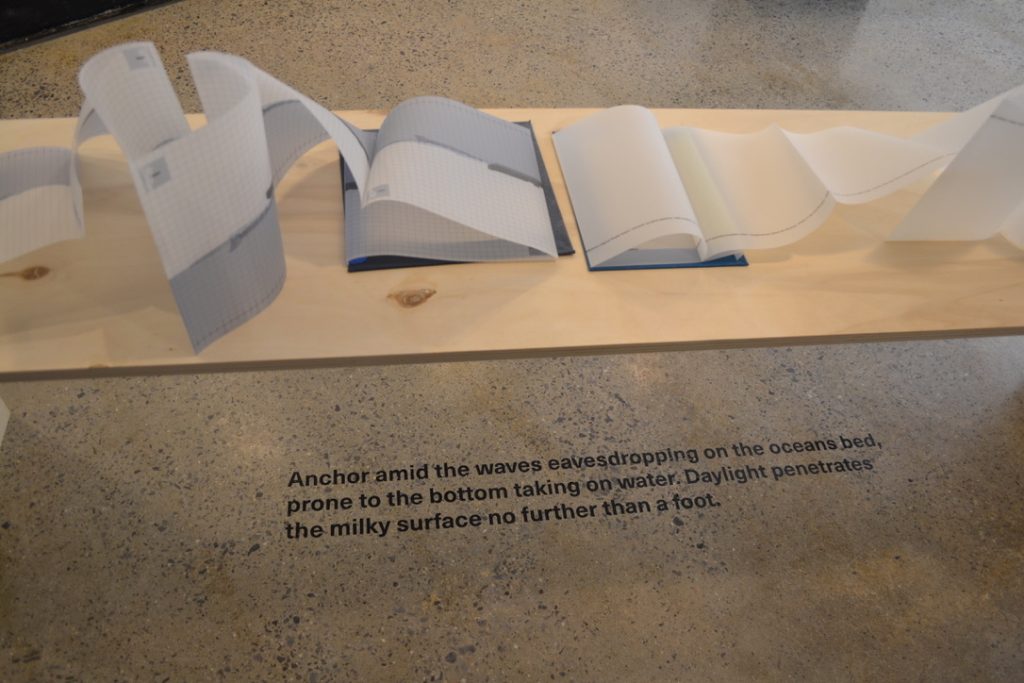
Emma Rath’s progress work presented during midterm reviews.
“When I teach seminars, I allow students to propose their own topics for research and writing,” says Dr. Bonier. “That way, their passions decide what they will make, learn, and do. I think this is why our students, and in particular our thesis program, have such great results.”
Bonier’s students generally work with issues of water and cities. Past students have developed projects around decommissioned industrial sites, a megacity’s shifting littoral edges, fragile glacier ecologies, privileged parks capes, post-Soviet cultural complexes, seen and unseen queer networks, brownfield riverfront sites, maritime fisheries, and ecotourism.
Rath’s article in NiCHE, Surfacing: Exploring the Canadian Coast Guard Archive, is an extension of an essay she wrote last winter in Bonier’s graduate seminar, Introduction to Critical Thought in Architecture. In it, Rath examines seemingly disparate issues, documentarian versus abstract photography.
“The essay prompt was open-ended,” says Rath, who is in the final year of the three-year Master of Architecture program.
“All that was required was to write about a photograph. Since this project was extremely flexible, I was able to explore my interests. It allowed me to experiment with descriptive writing following a personal passion.”
She chose the Canadian Coast Guard Photography Archive, where she has worked since 2020.


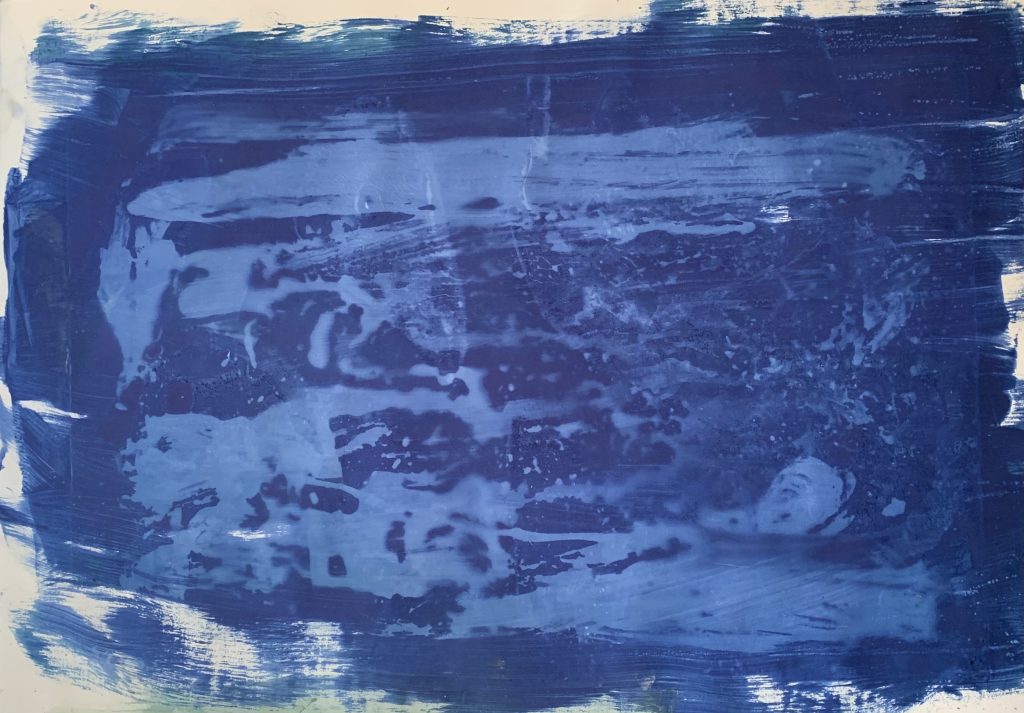
Emma Rath’s progress work presented during midterm reviews.
“Through digitizing their photo archive, I have the fortune of unearthing beautiful photos of water, ice, and vessels every day,” she says. “Through my work, I get to interact with breath-taking, interesting images. Choosing this topic was a way to give renewed life and agency to images that have largely been forgotten and stored away.”
The article is part of the series, Visual Cultures of the Circumpolar North, in partnership with the Jackman Institute for Humanities at the University of Toronto.
“Many images are not exact representations but blurred, recorded through fragmentary events and moments,” she notes. “These photos can offer the viewer an intuitive understanding of water by synthesizing the boundaries between scientific and abstract documentation.”
Writing the piece led her to realize the potential for an architectural thesis, produced in the final year of the master’s program.
“Archives are classically refereed by specific groups of people denoting what enters the archive and who enters the archive,” says Rath. “It is my ambition to create a space that does not abide by the hegemonic structure that is currently in place but design an archive that is open, unintimidating, and that encourages use of materials within archival space.
“Currently, I am exploring life-size maquettes of how visitors interact with my alternative designs to archival space,” she says. “I am exploring these through drawing, furniture making, bookbinding, photography, and printmaking. I am hoping to see how the archive can reflect the records that they hold through design interventions.”
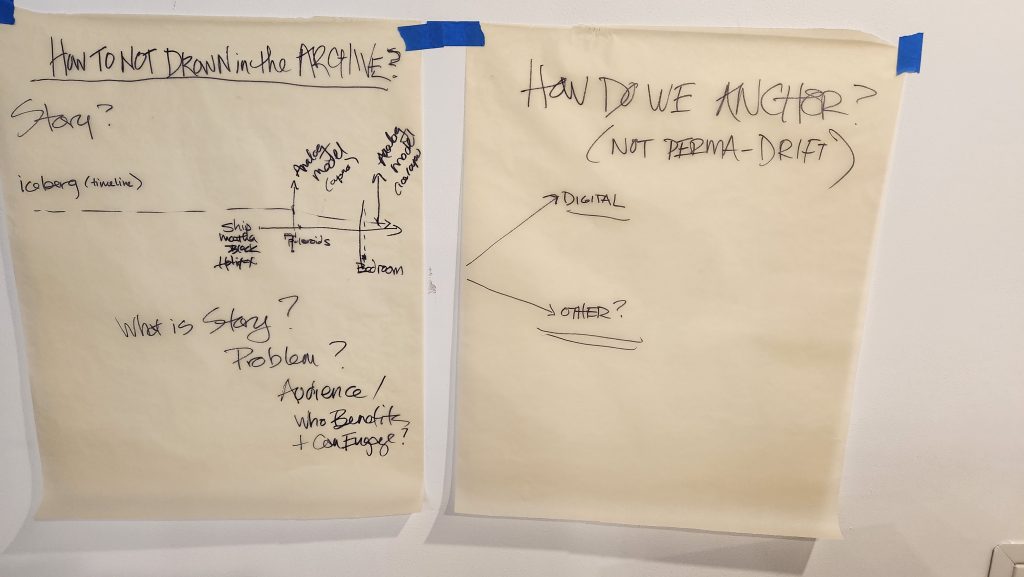

Emma Rath’s progress work presented during midterm reviews.
Rath found architecture “a roundabout way,” she says. “I was never gifted in maths, so from an early age I assumed architecture was off the table for me.”
Instead, she followed her love of art. She attended Canterbury High School in Ottawa, which has a specialized arts program.
In 2020, she obtained a Bachelor of Fine Arts with a major in Interdisciplinary Art and minor in Print, Paper, and Book from the Nova Scotia College of Art and Design University (NSCAD).
During her time at NSCAD, Rath exhibited work at the University of King’s Laundry Room Gallery, the Anna Leonowens Gallery, and the New York Book Fair. In addition, she served as a guide at the Canadian Pavilion during the 2017 Venice Biennale in Art, featuring artist Geoffrey Farmer. She also did an exchange at the University of Dundee in Scotland, where she worked as a curatorial assistant.
Rath holds a certificate in Managing Digital Archives from the International Council on Archives, an Accelerated Management diploma from Yale University, and maintains an interdisciplinary art practice ranging from conceptual installation work to printmaking and bookmaking.
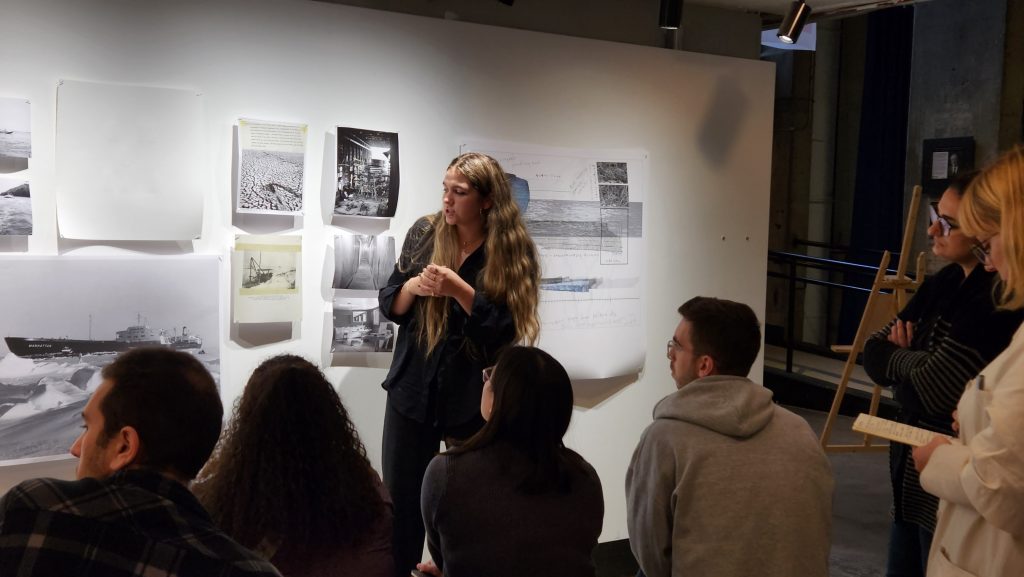
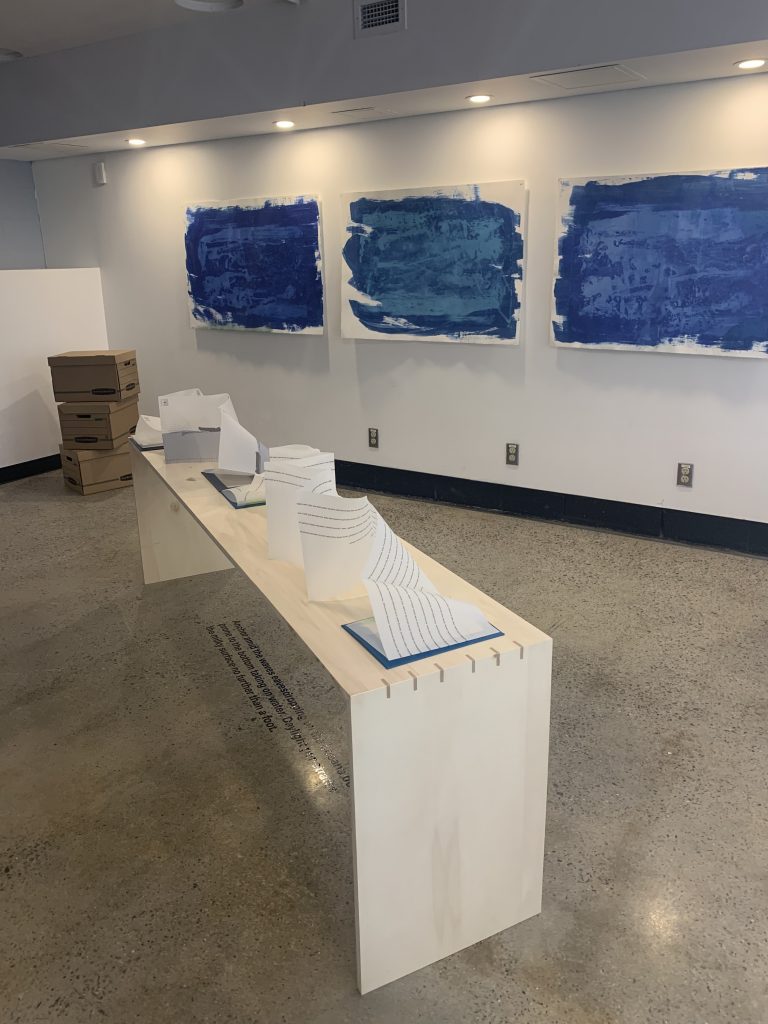
Emma Rath presenting her thesis progress during midterm reviews.
As the curation and exhibition design aspect of her practice gained speed, she started to experiment with architectural drawing conventions. This led to applying to Carleton’s three-year Master of Architecture program, which accepts students with undergraduate degrees in any field.
Her parents, both Carleton University graduates, encouraged this direction. Her mother, Ellen Treciokas, is a 2001 alumna of the school of architecture master’s program. Her father, Jonathan Rath, completed the industrial design program in 1987.
“What is so exciting about Carleton and my thesis work is the interplay between design, art, and architecture,” says Rath. “I have always been curious about finding ways to push, blend, dissolve the boundaries we create.”
She is unsure of what she will do after she graduates but is considering PhD programs, residencies, and design firms.
“There is an array of paths that I could take,” she says. “A wonderful facet of this degree is you can really go anywhere in an architectural, design, art, and culture capacity.”